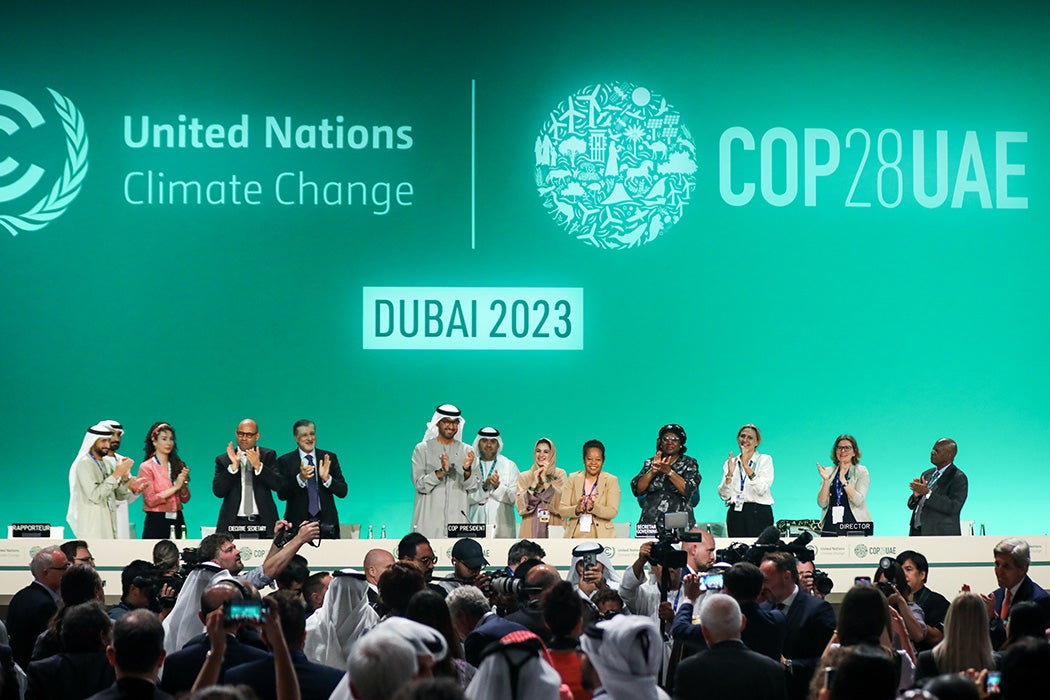The 2023 United Nations Climate Summit (COP28) ended last month after proceedings dragged into overtime for the final signing of the agreement. The future of fossil fuels took center stage, with activists, scientists, policymakers, and corporate players debating how best to keep global temperature rise under 1.5°C, a target set by the 2015 Paris Climate Agreement. The big question: Is a “phase-out” of fossil burning necessary, or will a more gradual transition away from the planet-warming fuel suffice? The COP28 resolution calls for transitioning away from fossil fuels (though with no particular timeline); the scaling-up of carbon capture, utilization, and storage (CCUS); tripling renewable energy capacity by 2030; doubling energy efficiency by 2030; and the adoption of a climate loss and damage fund for the most affected countries. Even so, this still may not be enough to change our trajectory.
Fossil fuel burning is the primary driver of carbon accumulation in the atmosphere. It perpetuates anthropogenic climate change by disrupting the natural cycling of carbon between the atmosphere, biosphere (land and oceans), and geosphere. Scientific literature demonstrates that continued fossil carbon emission, at humanity’s current rate, will push the world beyond 1.5°C of warming. Almost everyone agrees that something must be done to stop this. But what and when and how are questions that the various players answer differently.
The Controversial Solution: Removing Carbon from the Atmosphere
One controversial topic under discussion at the conference was the role of CCUS, or the industrial removal of carbon from the atmosphere for human use or durable storage in the geosphere, in a low-emissions future. As geophysicist Myles Allen remarked, advocating for upscaling of geospheric carbon storage, “we need to prevent fossil fuels from causing global warming before the world stops using fossil fuels.” Active carbon removal, coupled with durable, centuries-long carbon storage, could prevent the effects of fossil-fuel burning from materializing as further planetary warming. The UN’s Intergovernmental Panel on Climate Change (IPCC) found that carbon removal technologies must be bolstered to remain under 1.5°C, with a predicted need for 10–1000 gigatons of carbon removal, depending on the scenario. Though there are promising efforts to mobilize finance to speed up research and development for the deployment of industrial-scale CCUS, the technology is currently unavailable at the scale we need to draw down carbon.
Yet, as Robert Socolow warns in “Can We Bury Global Warming,” several key ethical and physical considerations must be considered before the large-scale implementation of CCUS. As a techno-fix, activists understand that CCUS does little to address disproportionate responsibility and the systemic inequities that laid the foundation for anthropogenic climate change. Currently, CCUS technology is used by oil and gas companies to enhance oil recovery, capturing CO2 emitted by industrial processes and injecting it into the ground to find further pockets of fossil fuels. Activists claim CCUS is being deployed as “climate saving technology” by emitters to delay tangible action and avoid inconveniencing companies’ operations and shareholders. The International Energy Agency also found that CCUS is incredibly energy-intensive and has recommended that it be reserved for harder-to-abate emissions, such as steelmaking and aviation.
The Promise of Renewable Energy
The COP28 agreement also calls for tripling renewable energy capacity while doubling energy efficiency by 2030. Renewables are indeed cause for hope, but there’s a catch. Yale economist Kenneth Gillingham and colleagues have found, that while improved energy efficiency is critical in reducing overall energy demand, rebound effects should be expected. “Buy[ing] a more fuel-efficient car,” they explain, can lead a person to “drive more…greater energy efficiency may even lead to a ‘backfire’ of increased industrial energy use.”
Weekly Newsletter
Furthermore, as researchers Hillard Huntington and Eric Smith explain, energy efficiency improvements don’t demand a switch from carbon-intensive to carbon-friendly forms of power generation. Even so, energy efficiency, coupled with a renewable energy transition, will significantly reduce carbon emissions and provide millions with clean, reliable, and arguably more democratically controlled forms of energy. The future of renewables looks promising, as the cost of deployment has significantly lowered over the past decade, significant investments have been made to improve battery storage, and greater regulatory incentives have emerged to hasten their adoption. Bolstering global renewable energy capacity is critical for reaching the 43 percent emissions decrease by 2030 needed for the Earth to remain under 1.5°C. Still, without clear efforts to repair injustices caused by uneven energy development, energy efficiency improvements and the upscaling of renewable energy can perpetuate inequities.
A Climate Loss and Damage Fund
In a bid to right their wrongs, the nations responsible for most of the world’s emissions have formally adopted a climate loss and damage fund. This fund aids climate-vulnerable nations in adapting and building resilience to the increased frequency and intensity of natural hazards, rising sea levels, and mounting biodiversity loss. Though there has been mounting criticism from activists regarding the logistics of the fund—such as how much is allocated and where it is housed—it’s viewed as a necessary first step in redirecting resources to communities that need support the most.
Furthermore, all countries will be required to update their Nationally Determined Contributions (NDCs) as part of their national adaptation plans to be reviewed in 2025. This update will support the development of the global inventory mechanism used by the United Nations Convention on Climate Change to track progress towards remaining under the 1.5°C target. The COP28 Climate Deal demonstrates that governments are cooperating to take coordinated and equitable actions to transition away from fossil fuel production and consumption and to bolster low-emissions technologies to build a carbon-free future for all. Though the resolutions from the deal appear in line with the global temperature target, complexities and challenges in equitable implementation, the necessity of swift action, and the unpredictable nature of technological innovations in CCUS and energy efficiency are all potential hurdles to be navigated.







